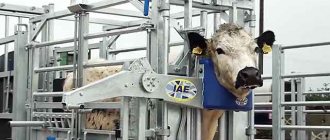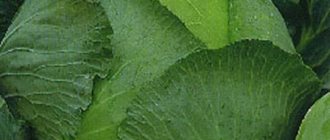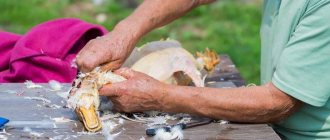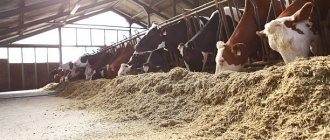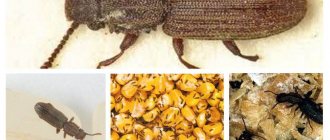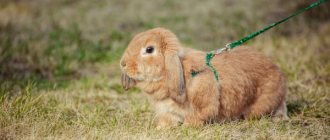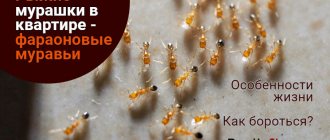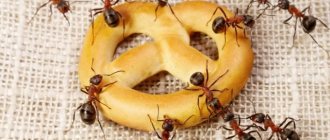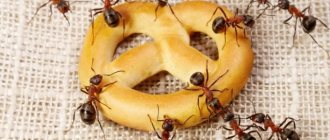Duck has very fatty and tasty meat, among other things, this meat is very healthy. It contains various amino acids, minerals and proteins. Considering its unpretentiousness in maintenance, many home owners choose ducks for breeding. However, after successful breeding, sooner or later the question arises about taking benefits from the animal, namely meat. Slaughtering a duck is not a difficult task. It’s much more difficult afterwards.
duck cutting
How to slaughter a bird
The most suitable time for slaughter is the age of 2.5 months after hatching from the egg. This is due to the fact that the first plumage is not yet rough, and plucking ducks will be much easier than later. Before carrying out the procedure, the livestock must be prepared. It is not recommended to feed ducks 12 hours before slaughter, but water should remain freely available to them.
The easiest way to kill a bird is as follows:
- ducklings are suspended by their limbs;
- the neck is grabbed with the left hand, stretched, and the carotid artery is cut with a sharp knife;
- the blood is collected in a separate container and after 20 minutes you can begin to remove the feathers and cut up the carcass.
How to divide a carcass into portions
Meat products must not only be tasty, but also look beautiful if they are to be sold.
In this case, you need to know how to cut the bird so as to get portioned pieces of the same size. You can cut the duck as follows:
- Using a sharp knife, all fat deposits, including subcutaneous ones, are cut off.
- If you plan to use the fat, you can freeze it for later.
- The bird is turned over on its back, and a cut is made from the middle of the sternum in the longitudinal direction along the entire keel to the bone.
- Using a knife, the meat is separated from the bones. You need to act so that as much pulp as possible is separated. The tip is directed along the costal part.
- At the next stage, you need to hold the keel with one hand, press the carcass to the surface with the other and with a sharp movement pull out the skeletal component along with the keel, ribs and ridge.
- The wings and limbs are the last to be separated from the duck. To separate the hams, the tendons are cut at the folds, in order to expend as little effort as possible, it is best to use a sharp knife.
- The chopped duck can be cooked immediately or saved for later.
- Wash the cut pieces and put them in the refrigerator.
Duck pieces in the oven with potatoes
This option for cooking duck is one of the most favorite among housewives. Spicy golden potatoes pair perfectly with savory duck. This is a universal recipe that does not require any additions.
Cooking time: 4 hours.
Ingredients:
- 500 gr. ducks;
- 500 gr. potatoes;
- 1 bunch of fresh dill;
- 3 tablespoons of mayonnaise;
- 100 ml. corn oil;
- 1 teaspoon mustard;
- 1 teaspoon dry ground paprika;
- salt, pepper - to taste.
Preparation:
- Cut the duck into small pieces, sprinkle them with pepper and salt.
- Mix mayonnaise with corn oil. Add mustard and paprika. Mix everything thoroughly and place the duck meat into this mixture.
- Let the bird marinate in the refrigerator for two hours.
- Peel the potatoes and cut them into slices. Season with salt and pepper.
- Grease a rimmed baking dish with oil. Place potato slices and duck pieces on it.
- Bake in the oven at increasing heat from 140 to 200 for about 1 hour.
- Finely chop the dill and decorate the finished dish with it.
Gutting rules
How to properly cut a pig carcass?
After singeing the skin, the carcass is placed under running water to wash off the carbon deposits. Then they begin to remove the insides. Algorithm of actions:
- Gutting begins from the neck. After cutting the skin in front, the trachea and crop are removed. Ducks destined for sale have their necks carefully removed, leaving a large piece of skin to cover the cut.
- The initial joints of the wings are trimmed. The paws are cut off a few centimeters above the heel joint.
- A small incision is made above the cloaca, through which the giblets are removed from the carcass. The liver, lungs, heart and stomach are separated from the tripe (the latter should be gutted). After washing them thoroughly, they are put aside to dry (these giblets will also be used for cooking).
- If the duck has built up belly fat, it is cut out.
- The sebaceous gland is removed from the tail part of the carcass. If this is not done, during the cooking process it will not only spoil the taste of the meat, but also the smell.
After removing all the entrails from the duck, the bird is thoroughly washed. In this case, there is no need to keep the carcass in water for a long time (the taste of the meat will deteriorate). If you plan to freeze the bird in the future, place it on a net to drain and dry.
Searing the carcass
Searing is necessary to remove small hairs and fluff that would take a lot of time to remove manually. In addition, this process gives the duckling skin a pleasant aroma and color.
The simplest, most reliable and most common method of singeing is using a gas burner. The procedure is very simple and even an inexperienced person can handle it. The procedure is as follows:
- cut off the wings and paws of a plucked duck; they are singed separately;
- remove the lid from the gas burner and light the fire;
- bring the part of the duck you want to process to the fire;
- At the end of the process, wash the duck from carbon deposits and wipe with a dry, clean cloth.
During singeing, it is necessary to carefully monitor the process and prevent the skin from baking and subcutaneous fat from melting. Pay due attention to processing the carcass in hard-to-reach places, because any omissions will be visible to the buyer or members of your family. In nature, if you don’t have a gas burner, you can singe the carcass over a fire, and for those who for some reason don’t have a gas stove in their house, you can buy a hand-held gas burner.
Preservation of fluff
Down and feathers are valued as raw materials. The procedure for preparing fluff:
- Rinse the fluff in warm water, adding a little washing powder.
- Rinse the fluff in cold running water.
- Squeeze out the water.
- Place the down in a fabric bag and hang to dry. It is advisable to hang the bag in the sun.
- Stir the fluff periodically to prevent it from rotting or caking.
To wash feathers, soak them in a soapy solution for 30 minutes.
Manually plucking a duck is a labor-intensive and painstaking process that requires a certain skill. The condition of its skin, the taste of the meat and even its shelf life depend on how correctly the bird is plucked.
0
0
Copy link
Plucking methods
It is recommended to remove feathers 2-3 hours after killing. During this time, the subcutaneous fat will harden, which will allow less trauma to the skin. Initially, all large tail and wing feathers are removed, then the neck and sternum are plucked.
Plucked ducks
There are several methods for plucking carcasses.
Using the dry method, which is the most popular, especially in the home. To comply with the technology you need to do the following:
- The duckling is laid out on a prepared bedding made of fabric or paper. A large feather is pulled out according to its growth, which allows you to leave the skin intact and unharmed.
- Then the feathers are removed from the sternum, dorsal and cervical regions.
- After the main cover is removed, the carcass is sprinkled with flour, and the remaining small feathers are removed by singeing.
- Burn with a gas burner for literally 2-3 seconds so that the subcutaneous fat does not begin to melt and the skin itself does not burn.
- At the last stage, the bird is washed in cold water and the carbon deposits are removed.
scalding procedure
It is one of the most common methods for quickly ridding ducks of feathers. The following actions must be taken:
- the finished carcasses are placed one by one in a specially selected pan;
- water heats up to +80 degrees;
- carefully turning the duck over and scalding it;
- then the carcass should be filled with water and left for 15 minutes;
- pull out the duck, let the water drain, pluck;
- the last action is scorching.
With the chosen method, you will notice that the meat will change its color slightly; this is a completely normal reaction that occurs during heat treatment.
Using the hot method
Another technology is used for plucking ducks:
- you will need to get some burlap, soak it in hot water, squeeze it out and wrap the duck;
- let sit for up to 20 minutes;
- Use an iron to carefully go over the fabric;
- it is important to be careful not to get burned;
- The last step is to remove the feather cover.
Basic methods
Cooking duck is almost painless, while butchering is considered a problematic task. But this can be avoided, since carcasses that have already been plucked are often sold at the bazaar. The owner just needs to take them in her hands and scorch them with fire to remove the remaining hairs.
Things are somewhat different with domestic ducks. First they are raised, then they are slaughtered, and then the question arises of plucking and butchering. There are several main methods. According to the dry method, plucking is carried out immediately after slaughter. At the same time, singeing is done. The dry method allows you to get rid of fluff, large and small feathers. The algorithm of actions is as follows:
- Sit in a comfortable position.
- Place a container for feathers and down, for example, a bucket or a wide basin, in close proximity.
- The duck is placed on the lap so that the head hangs down.
- The fluff and feathers are carefully removed, being careful not to catch the skin.
- The remaining fluff is removed with a knife, pressing it to your finger and pulling out the hair with a sharp movement.
After this, take a burner, scorch the surface of the skin, straighten it so that there are no folds. The fire should not be located too close to the carcass, otherwise the subcutaneous fat will melt. Rubbing with flour will help get rid of excess moisture, which causes your fingers to slip all the time. In the future, it can be washed off along with the resulting soot. The pulling technique is especially important. Feathers must be torn off sharply. This should be done against hair growth, adhering to the following algorithm:
- treat the chest area;
- move to the back, shoulders and neck;
- remove the so-called flight feathers located on the wings;
- at the final stage they are taken as the tail section.
The advantage of this method is the absence of blood. But it also has some disadvantages, for example, time costs. The procedure takes a long time and requires perseverance from the hostess. If she is not patient, you may notice the remains of feather shafts on the duck skin. They will create obstacles to further cooking of the bird. In any case, this method is used for high-quality cleaning of the carcass.
Storage of duck feathers and down, areas of application
Feather and down are valuable raw materials in the household. It is used to fill pillows and make quilts. Down is also used in the production of woolen knitted products, handicrafts and even interior decoration. Feathers growing in wing flaps are used as a protein supplement to the diet of animals (ground into powder).
Duck feathers are used as filler for blankets and pillows
Small details:
- the feather yield from one duck carcass is on average 115–125 g (for comparison, more from a goose, less from a chicken);
- Some of the procurement of raw materials begins while the bird is still alive. During molting twice a year (in spring and autumn), the duck still loses its down, and sometimes some of its feathers. Both are collected, gradually accumulated;
- raw materials from carcasses after slaughter are also suitable if they are collected correctly and do not spoil the tissue structure.
- Collected feathers and down are sorted separately from each other (sorting will take a lot of time, but there is no way to do without it).
- Rinse the material to clean water. You can use delicate detergents, but it is best to make a solution of laundry soap.
- Dry it. To prevent raw materials from scattering from the slightest draft, it is recommended to place them in spacious gauze covers. As it dries, you need to turn the bag over several times to prevent the contents from sticking together.
- Small feathers after plucking carcasses can be used together with the trunk, since it is soft and flexible and will not prick in pillows and blankets.
- Large feathers, unless we are talking about decoration, are stripped of vegetation. These fibers are subsequently mixed with fine feathers and/or down and used for filling blankets, pillows, and quilted clothing.
- Until all the material is used, it is stored in thick fabric bags or in containers with a lid. The required quantity is obtained as needed. If they were dried correctly during preparation, the feathers and down will be well preserved without the appearance of lice.
How to cut a duck into portions at home
The cutting method will depend on the type of dish.
Proper cutting of a duck carcass will save time. It makes sense to decide on the cutting method in advance. Depending on how you plan to use the meat in the future:
- in small portions (stewed in gravy, with vegetables, on the grill);
- in large pieces for baking over a fire, in the oven or wrapped in foil;
- preparing broth and boiling meat for salads.
Be sure to gut the duck before cutting.
- Make a hole in the cloaca area with a sharp knife.
- Cut through the belly of the carcass from this point to the breast bones.
- Remove the intestines.
- The goiter and esophagus are removed through an opening on the side of the neck.
When removing the entrails, try not to damage the spleen - otherwise bitterness will get into the meat. The heart, liver and stomach are usually used to make giblet soup.
Getting started - removing the head and neck. Use a sharp, heavy knife so that it can easily cut through the vertebral component in these places.
Cutting into segments
The duck carcass is cut from the throat to the keel along the spine
- Remove the wings by cutting them along the joints at the folds.
- The carcass is cut as much as possible from the throat to the keel.
- Divide with a sharp knife into two halves along the spine.
- Both halves are washed with water, dried, wrapped in film and stored in the freezer. Or they immediately take one part and cook it.
- As an option: everything is the same, but the breast is separated further from each half (it is considered more dietary than the rest of the carcass).
It is permissible to cut the carcass without removing subcutaneous fat. It is easier to do this for each part immediately before cooking. Campfire recipes require the presence of fat: while the meat is cooked, the fat melts and creates an appetizing crust.
Portion cutting
The limbs are cut at the bends
- The bird is turned over on its back.
- An incision is made along the keel to the bone, starting from the middle of the sternum.
- The meat is separated from the bones using a knife. Hold the knife close to and along the rib to remove as much flesh as possible.
- They press the carcass to the tabletop, clamp the keel with one hand, and with the other, sharply pull out the skeletal part of the carcass (including the spine, ribs and keel).
- Now it’s the turn of the limbs and wings. They are also separated.
- Ham. At the folds there are tendons - they are cut along them with a sharp knife to separate the thighs from the carcass, as well as the drumsticks from the thighs.
- The fat is cut off with a sharp knife along with the skin. It will be useful later for various culinary or medicinal purposes. However, this is not a prerequisite.
- The pieces are washed with water and lightly soaked with a clean towel or paper napkins. The required amount is prepared, the rest can be put in the freezer.
Video: how to quickly cut up a duck carcass
Duck meat is a worthy element of the family table, including holiday feasts. When plucking a carcass, you need to be able to get rid of hard residues (the edges from which the feathers grow). Then the cooked skin will delight consumers with its softness.
Roasted duck is often served on a festive table.
Don’t throw away feathers and fluff; they will find use in the household and even in creativity. When cutting, be sure to remove the glands in the tail section. The sharp, specific smell of duck secretion will spoil the taste of the broth, as well as the meat itself. It is difficult to cope with the task only for the first time. Further experience is quickly accumulated, and carcass processing is greatly simplified.
- Author: Loria
Rate this article:
- 5
- 4
- 3
- 2
- 1
(4 votes, average: 3.3 out of 5)
Share with your friends!
How to gut it correctly?
The first step is to make a special hole near the cloaca through which the intestines will be removed. This procedure is important, especially if you intend to send the duck for freezing.
Duck cutting
You can properly cut a duck by following simple rules:
- chop off a duck's head
- neck cutting;
- wings with limbs also need to be separated, the first ones are cut off at the initial joints;
- make an incision in the abdominal cavity and gut the bird (all the entrails are removed, you can use them to make broth or minced meat);
- the gutted entrails are placed in a separate container;
- Rinse offal before use;
- the esophagus and goiter are removed through an opening in the neck;
- Fat deposits on the belly also need to be removed.
The gutted carcass must be washed, dried and frozen.
Poultry slaughter - sequence of steps
Depending on the breed, duck meat has different taste and weight. Mulards are more fleshy than their relatives. To get quality meat, you need to know when the bird is ready for slaughter. The main sign is the condition of the pen. As a duck grows, the plumage becomes coarser and stiffer. You should wait until the first feather covering grows. Young feathers on the wings should not yet become coarse.
The best age for slaughter is 2-2.5 months for the Pekingese breed and 3 for Indo ducks. Such a bird is easy to pluck, and the meat tastes good. If you miss the moment, it becomes tasteless, the feathers are poorly plucked, and stumps remain. In this case, wait until the juvenile moult has passed, new feathers of sufficient length grow, then it will be easier to pluck the duck.
For beginners, slaughtering a bird is a real test; to make it easier to endure, you need to follow the step-by-step instructions. Do not feed the ducks for half a day; you can make them fast for about 12 hours. Water is provided without restrictions. The selected batch is placed in a separate room and the lights are turned on all night. These actions are necessary to free the bird's crop, stomach and intestines from food debris and excrement.
Slaughter is carried out externally, following the sequence:
- The duck is hung upside down by its legs. The wings overlap each other. Experts use a metal cone for this.
- Taking the duck by the head, stretch the duck's neck and cut the carotid artery. During the procedure, the knife is not held at a right angle to the neck, but with a slight downward tilt.
- Then they wait for the blood to drain. This takes from 15 to 20 minutes.
- Next they move on to plucking, gutting and cutting.
You can kill a duck. But this requires experience: you need to chop off the head accurately with a sharp ax so as not to cause unpleasant moments for either the bird or yourself.
frozen duck
Some housewives freeze the duck along with its feathers. This phenomenon is more typical for farms where poultry has to be procured in large quantities. Hunters who obtain a trophy for their household members also resort to this method, but do not process it immediately. Plucking a frozen duck is difficult because:
- You will have to spend time defrosting, which will take several hours.
- During the thawing period, bacteria will multiply, which will require additional heat treatment to protect against microbial contamination.
- It is difficult to visually determine when to start removing feathers.
- To treat a frozen duck, you need to leave it for several hours until traces of frost and ice on the feathers disappear. The skin will become soft and the feather bulb will be easy to remove.
You should dip the duck into a bucket where boiling water has been poured in advance. This must be done quickly so that the skin does not cook. The main task here is to expand the pores. Feathers are removed manually. After treatment with boiling water, this is done easily and without problems. Where there are areas of fine hairs left, you can go through with lighted matches or a torch.
Unconventional techniques
A popular and at the same time unusual approach to duck plucking is the hot bag method. There are several areas of this technology. The simplest one requires that at least 4 hours have passed since slaughter.
The duck is wrapped in burlap and then steamed with an iron . This must be done extremely carefully , otherwise there is a risk of damaging the surface of the skin. The bag must first be soaked in hot water and wrung out. Only after this is it allowed to wrap the duck in it. But don’t immediately take up the iron. You must wait 15 minutes.
After this, take the heated device and run it over the surface of the burlap. This way the steaming effect is achieved. You need to do this for 10 minutes. At the final stage, feathers and fluff are removed. Heat treatment makes it easy to get rid of any vegetation. Begin the plucking process from the breast. After this, they move to the back. Next they go towards the neck and wings. The only drawback of the method is the likelihood of burns. But by being careful, you can make your job much easier when removing fluff and feathers.
The second option involves wrapping it in a bag and using a knife. As soon as the duck is wrapped in burlap, take a wide bucket parallel and fill it with hot water. The bag is dipped into this liquid with rapid movements several times. The duck should not be allowed to linger in it for a long time, otherwise it will be cooked. A few minutes of exposure to heated water is enough to enlarge the pores on the skin.
Take out the duck and remove all the feathers using a knife. Feather stems, which are dense and have a rough structure, should be removed with the blunt side. This method is suitable if you have certain skills. It is better for an inexperienced person not to use it.
Using a bag, regardless of which method was used, has the potential to change the color of the meat. If this indicator is important for preparing a duck dish, it is better to use some other technique. On the other hand, cleaning feathers with this approach is almost ideal.
Meat storage conditions
Only good quality meat can be stored. To maintain juiciness and freshness, you must adhere to the following rules:
- Rub the meat with coarse salt;
- It is better to store on a separate shelf, without other products;
- the ideal storage method is ice crust;
- Only completely gutted ducks can be stored.
It is recommended to store meat in the freezer for up to six months.
Did you know? Despite the fact that visually ducks have a short neck, they have much more cervical vertebrae than giraffes.
Gutting
As you can see from the videos below, gutting poultry is one of the main steps in the cutting process. If you gut a duck incorrectly, then the insides will remain inside it, which will negatively affect the taste of the meat and the aesthetic appearance of the carcass as a whole.
Therefore, the issue of evisceration should be given special attention. So, how to gut a bird correctly?
- First you need to prepare a knife and cut off the paws; you don’t need them and will go to waste. After this, an incision should be made in the neck and the trachea should be separated from the neck meat. Then you should make a cut in the belly of your duck, it should be made along a line that visually divides the belly in half. The goose is cut off, while trying not to catch the insides. Grasp the stomach with one hand and begin to pull out the contents of the abdomen, while using the other hand to help from below to make it more comfortable.
- Then you should pull the stomach a little, while pushing the trachea into the cavity of the duck. This way you can easily remove the intestines from the carcass. Do this carefully so that some of the entrails do not remain inside.
- Let's move on to the next stage of gutting. First of all, the heart is separated, then the bile is cut out from the liver, an incision is made on the stomach, which is subsequently cut. The stomach must be cleaned from the inside with a knife, after which it is washed. After all these manipulations, you can remove the skin that covers the stomach from the inside. In the case of a duck or goose, there may be problems with cutting out the inner skin, but under no circumstances should it be left on.
- Then you can feel the lungs between the ribs of the carcass; in a duck they may be clogged with sand. The sand, as you understand, also needs to be washed; you don’t need it at all. It is advisable to rinse the carcass under strong water pressure, otherwise it will be difficult to remove all the sand.
- The last stage of cutting, as you can understand from the video, will be the separation of the tail. Directly above the tail you can see the glands, which, in fact, secrete the secretion. When the duck is cooked, the glands will emit a very unpleasant odor, which can result in spoilage of the broth. Therefore, the glands must be completely excised.
When all the insides of the duck are gutted, the duck should be washed under the pressure of warm water. Then take soda and, without sparing it, wipe the carcass until it becomes lighter. Leave the carcass to cool before proceeding to cutting. In general, the process is not particularly complicated; detailed nuances are outlined in the video.
Peking style cutting
Beijing chefs are famous for their ability to cut a duck into hundreds of small pieces. In Chinese cuisine, bones are also a full-fledged part of the dish, but cutting Peking duck requires cutting off the meat and exposing as much of the skeleton as possible without cutting it. You will need a sharp, thin knife with a wide blade.
Cutting begins with the breast. A thin strip of skin with a layer of meat 0.5 cm thick is cut in. Next, the meat is cut into small, neat slices. After the breast is finished, the duck leg is broken out of the thigh joint, the meat is cut off from the shoulder and the thigh itself, then from the shin of the bird. The wings come last. The operation is repeated on the other side. Ideally, what remains is the carcass of the duck and the meat completely cut off.
Some tricks
When the tail part separates, you need to pay attention to the nearby glands to secrete secretions. If they are not removed, then during cooking they will begin to emit a more than specific smell, which will completely make the broth unsuitable for consumption.
When cutting into portioned pieces, it is recommended to leave them with the skin on in order to subsequently obtain a golden brown crust when frying.
It is not advisable to use an ax; it would be more convenient to take kitchen scissors for the job. They cut bones perfectly, without any additional effort.
It is recommended to cut along the joints so that bone particles do not end up in the meat pulp, in addition, the risk of getting cuts from sharp bone edges is minimized, and you do not have to waste time disassembling the bones.
One question remains - how to cut up a wild duck and gut it? There is nothing complicated here, all the methods described above are suitable.
If you follow all the rules, gutting a duck is not so difficult; the main thing to remember is that the more carefully the bones are separated, the more meat you can get from the muzzles.
How to pluck with a nozzle
Technological progress has also reached poultry farming, making it possible to use mechanical devices for plucking birds at home. The so-called feather removal attachment for a drill, hammer drill or grinder will help with this. The device has a rather “spiky” appearance with multi-directional corrugated rubber “fingers”.
Read how to properly pluck chicken, duck and goose using a nozzle.
To use the attachment, use a drill, hammer drill, screwdriver or other power tool with adjustable rotational motion. The job of the attachment is to pluck feathers from a duck using a device that, with its high-speed movements, imitates the movements of human fingers. To pluck in this way, you just need to securely fasten the tool and bring the bird carcasses to it.
Plucking the duck using a nozzle
When breeding ducks, the poultry farmer must comply with a number of conditions and responsibilities. Find out how to raise ducks at home.
Mechanical methods for removing feathers
Modern developments by specialists and amateurs offer mechanical devices for plucking birds. There are attachments for drills and entire machines.
Pen removal machine
Pen removal attachment
The attachments are wide bits with rubber fingers. It is difficult to remove flight feathers with them, but they cope with smaller ones quite successfully. The video below shows what the nozzle looks like and how it works.
Video - How to pluck a bird using a nozzle
Plucking machines are larger in size, but more efficient when processing a large number of carcasses. The ducks are placed in a drum with fingers, which spins like a washing machine. Craftsmen make such units from just such old equipment. The second option for an amateur feather picker is a large pan with a motor.
Useful tips
To make the plucking process easier, it is recommended to know some recommendations:
- To cool the fat under the skin and thus preserve the integrity of the skin, it is best to remove feathers at least 3 hours after slaughter.
- Large feathers are pulled out only in the direction of their growth.
- To prevent the fluff from flying away during plucking, it is first sprayed with water.
- It is better to slaughter a bird at a time when it is not molting.
This knowledge will help you quickly and, most importantly, efficiently not only pluck, but also cut up a duck carcass at home. It is important to adhere to the stated rules and then you should not have any problems.
Preparation and necessary tools
The question of how to properly butcher a pig is of great importance. Further processing and storage depend on proper cutting. In addition, meat from different areas of the pork carcass has different culinary properties and selling prices. Any difficulties in the process of cutting carcasses can be overcome. The main thing is to do everything right.
Pigs are usually slaughtered in late autumn, when the air temperature is quite low, and the weight of a pig at the age of 8 to 10 months is 80-120 kg. The animal should not eat anything 24 hours before slaughter to cleanse the intestines, except fresh and clean water. If a boar is subjected to cutting, then first of all after slaughter it is necessary to remove the genitals to avoid an unpleasant odor.
There are two types of pig slaughter: vertical and horizontal. The first method is the simplest. The pigs are suspended by their hind legs and the jugular vein is cut. In the horizontal method, the animal is killed with a knife in the heart. An important point during slaughter is the removal of blood. The absence of blood in a pig carcass not only improves the overall appearance, but also significantly improves the quality of the final product.
In order to disassemble a pig into parts, you need certain equipment. The cutting scheme is quite simple, but in practice it is a rather labor-intensive process. The average weight of a pig suitable for slaughter is approximately 120 kg, which should yield about 65 kg of meat. Required cutting tools include:
- sharp stainless steel knives no less than 15 cm long;
- carcass hook;
- hacksaw for cutting bones;
- container with water;
- bucket;
- large flat work surface.
